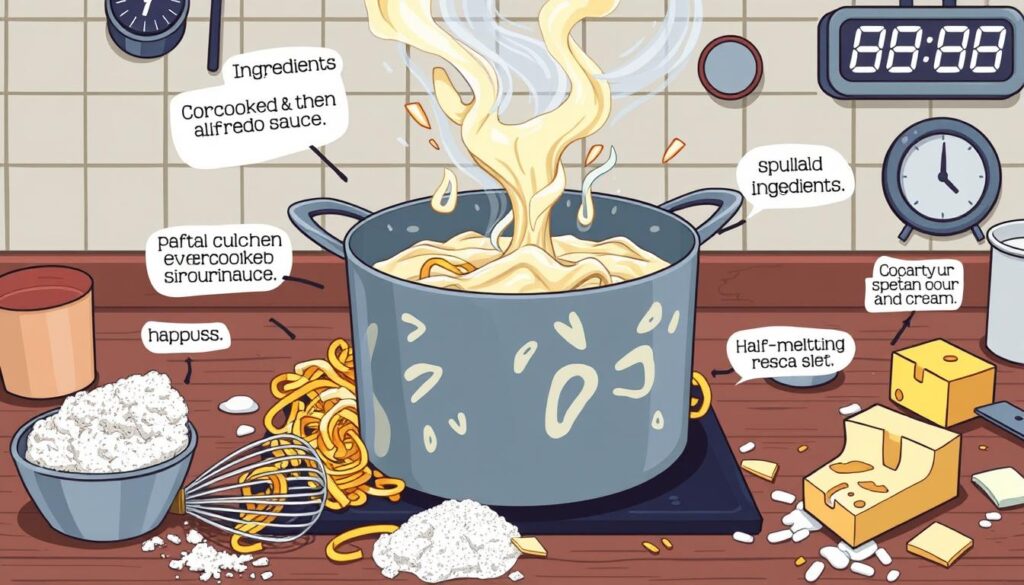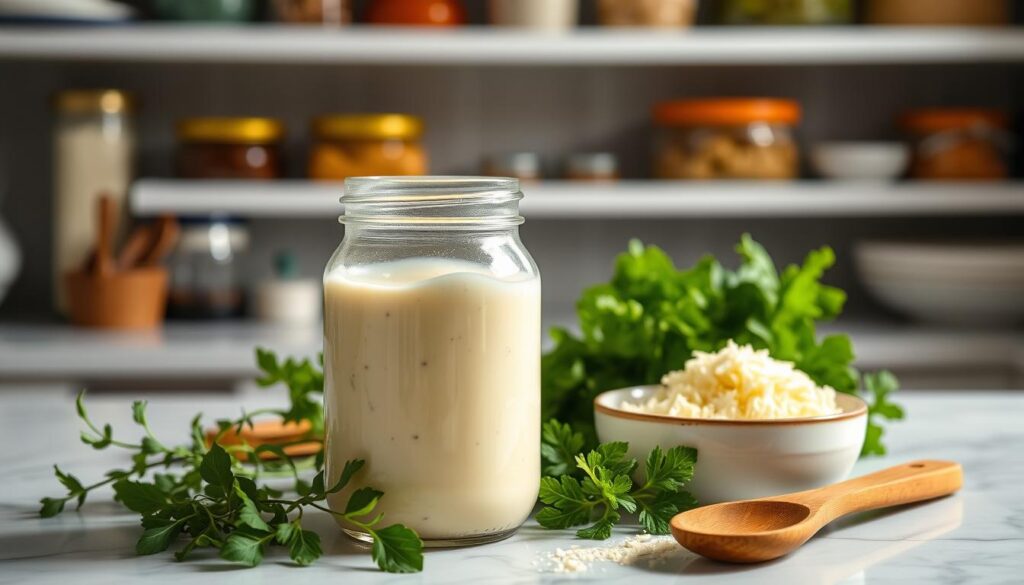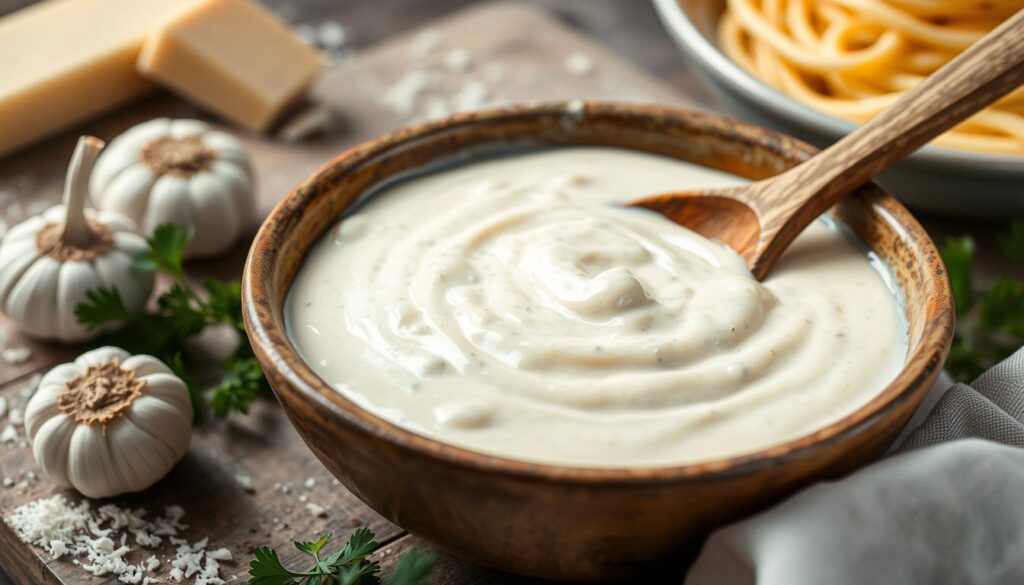Indulge in the best homemade alfredo sauce recipe. Creamy, silky, and bursting with garlic and parmesan flavor.
Table of Contents
Discover the authentic taste of Italy with our homemade alfredo sauce recipe, featuring high-quality ingredients like parmesan cheese and fresh parsley. This italian recipe is perfect for those looking to create a delicious and creamy dish at home. Our alfredo sauce recipe is a classic, with a rich and flavorful taste that will leave you wanting more.
With this homemade alfredo sauce, you can enjoy the authentic taste of italian recipes in the comfort of your own home. Our recipe is easy to follow and requires minimal ingredients, making it a great option for a weeknight dinner or special occasion. Whether you’re a fan of traditional italian cuisine or just looking to try something new, our alfredo sauce recipe is sure to please.
Our goal is to provide you with the best alfredo sauce recipe, one that is both creamy and flavorful. We’ll take you through the history of alfredo sauce, the essential ingredients, and the step-by-step cooking process to ensure you achieve the perfect dish. With our homemade alfredo sauce recipe, you’ll be able to create an authentic italian experience that will impress your family and friends.
The Rich History of Alfredo Sauce
Alfredo sauce has a rich and fascinating history of alfredo sauce that spans nearly a century. The origins of this beloved sauce are deeply rooted in italian cuisine, specifically in Rome’s restaurant scene. It is often attributed to Alfredo Di Lelio, who created the sauce in the early 20th century.
The alfredo sauce origins story begins with Di Lelio’s restaurant, Alfredo’s, where he served the sauce to his customers. The sauce quickly gained popularity, and its history of alfredo sauce became intertwined with the history of italian cuisine. Over time, the sauce evolved, and various adaptations emerged, including American versions that modified the original recipe to suit local tastes.
Origins in Rome’s Restaurant Scene
In Rome, the sauce was initially served with just a few ingredients, including butter, Parmesan cheese, and pasta. The simplicity of the recipe was part of its charm, and it quickly became a staple in italian cuisine. As the sauce gained popularity, it began to spread to other parts of the world, including the United States, where it underwent significant changes to become the alfredo sauce we know today.
Evolution of the Classic Recipe
Today, alfredo sauce is a staple in many restaurants around the world. The sauce has undergone many changes, with various ingredients being added or substituted to create new and exciting flavors. Despite these changes, the core ingredients of the original recipe remain the same, and the sauce continues to be a beloved part of italian cuisine.
| Ingredient | Original Recipe | Modern Adaptations |
|---|---|---|
| Pasta | Fettuccine | Various types, including spaghetti and linguine |
| Cheese | Parmesan | Combination of Parmesan and other cheeses, such as mozzarella and ricotta |
| Sauce | Butter and Parmesan | Various sauces, including cream-based and tomato-based |
Essential Ingredients for Perfect Alfredo Sauce
To create the perfect Alfredo sauce, it’s crucial to focus on the quality of alfredo sauce ingredients. The selection of these ingredients can significantly impact the final taste and consistency of the sauce. Key components include parmesan cheese, garlic, and heavy cream, which are essential for achieving the sauce’s signature creamy and flavorful texture.
A good parmesan cheese is the foundation of a great Alfredo sauce. Look for high-quality, freshly grated cheese to ensure the best flavor. Garlic is another vital ingredient, adding a depth of flavor that complements the richness of the cheese and cream. When combined with alfredo sauce ingredients like heavy cream and butter, these elements create a sauce that’s both decadent and delicious.
Here are some key points to consider when selecting alfredo sauce ingredients:
- Choose high-quality parmesan cheese for the best flavor
- Use fresh garlic for added depth of flavor
- Select heavy cream that’s high in fat for a rich and creamy sauce
By focusing on these essential alfredo sauce ingredients and using them in harmony, you’ll be able to create a perfect Alfredo sauce that’s sure to impress. Whether you’re a seasoned chef or a beginner in the kitchen, the right ingredients will make all the difference in the world.
| Ingredient | Importance | Tips |
|---|---|---|
| Parmesan cheese | High | Freshly grated for best flavor |
| Garlic | Medium | Use fresh garlic for added depth |
| Heavy cream | High | Choose high-fat cream for rich sauce |
Kitchen Equipment You’ll Need
To prepare the perfect Alfredo sauce, you’ll need the right kitchen equipment and cooking utensils. This includes saucepans, wooden spoons, and a colander. Having the necessary tools will make the cooking process easier and more efficient.
A good set of saucepans is essential for heating the sauce evenly. Look for saucepans made from high-quality materials, such as stainless steel or copper, that can distribute heat well. In addition to saucepans, you’ll also need cooking utensils like wooden spoons and spatulas to stir and mix the sauce.
Here is a list of the required kitchen equipment and cooking utensils:
- Saucepan
- Wooden spoon
- Colander
- Spatula
Optional equipment, such as a food processor, can also be useful for blending ingredients and creating a smooth sauce. Proper storage containers are also necessary for keeping the sauce fresh.
| Equipment | Description |
|---|---|
| Saucepan | For heating the sauce evenly |
| Wooden spoon | For stirring and mixing the sauce |
| Colander | For draining pasta |
Classic Alfredo Sauce Recipe
To create an authentic classic alfredo sauce recipe, it’s essential to understand the fundamentals of italian cooking. This traditional sauce is a staple in Italian cuisine, and its rich flavor profile is achieved by combining simple yet high-quality ingredients. A homemade sauce made with love and care is always superior to store-bought alternatives.
When preparing a classic alfredo sauce recipe, it’s crucial to use the right ingredients, including Parmesan cheese, butter, and heavy cream. These components work together in harmony to create a creamy and indulgent sauce. By following a traditional italian cooking approach, you’ll be able to craft a delicious homemade sauce that will elevate your pasta dishes to new heights.
To get started, gather the necessary ingredients and equipment, and then follow a simple yet effective process to create your classic alfredo sauce recipe. This may involve melting butter, whisking in flour, and gradually adding heavy cream to achieve the perfect consistency. With a little practice and patience, you’ll be able to master the art of italian cooking and enjoy a delicious homemade sauce that’s sure to impress your family and friends.
Some key tips to keep in mind when preparing a classic alfredo sauce recipe include:
- Using high-quality ingredients to ensure the best flavor
- Whisking constantly to prevent lumps from forming
- Adding Parmesan cheese gradually to achieve a smooth and creamy texture
By following these tips and staying true to the traditionalitalian cookingmethods, you’ll be able to create a mouthwateringhomemade saucethat’s sure to become a staple in your kitchen.
Step-by-Step Cooking Process
To master the art of cooking alfredo sauce, it’s essential to follow a step-by-step guide. This process involves several key stages, from preparing your ingredients to achieving the perfect sauce consistency. By breaking down the cooking process into manageable steps, you’ll be able to create a creamy and flavorful sauce that’s sure to impress.
First, preparing your ingredients is crucial. This involves gathering all the necessary components, including high-quality pasta, fresh parsley, and a blend of parmesan and butter. Next, creating the base of the sauce requires melting the butter and whisking in the flour to create a smooth roux. This is a critical step in achieving the perfect sauce consistency.
The following steps involve achieving the perfect consistency and final seasoning. To achieve the perfect consistency, it’s essential to slowly pour in the milk while continuously whisking the sauce. This will help to prevent lumps from forming and ensure a smooth, creamy texture. Finally, seasoning the sauce with salt, pepper, and a sprinkle of parmesan cheese will add depth and flavor to the dish.
By following this step-by-step guide, you’ll be able to create a delicious and authentic alfredo sauce that’s sure to become a staple in your kitchen. Remember to always use high-quality ingredients and to take your time when cooking the sauce, as this will help to ensure the best possible results.
| Step | Description |
|---|---|
| 1. Prepare ingredients | Gather all necessary components, including pasta, parsley, and parmesan cheese. |
| 2. Create the base | Melt butter and whisk in flour to create a smooth roux. |
| 3. Achieve perfect consistency | Slowly pour in milk while continuously whisking the sauce. |
| 4. Final seasoning | Season the sauce with salt, pepper, and parmesan cheese. |
Troubleshooting Common Issues
When making Alfredo sauce, several issues can arise, including alfredo sauce problems such as the sauce being too thick or too thin. To address these issues, it’s essential to understand the causes and solutions. Common causes of a sauce too thick include overcooking the sauce or using too much flour. On the other hand, a sauce too thin can be caused by using too much cream or not cooking the sauce long enough.
To troubleshoot these issues, consider the following tips:
- Adjust the amount of cream or flour to achieve the desired consistency
- Cook the sauce for a longer or shorter period to thicken or thin it out
- Add a little more butter or cream to enrich the flavor and texture

By understanding the common alfredo sauce problems and their solutions, you can create a delicious and creamy sauce that complements your dish. Remember to taste and adjust the sauce as you go, and don’t be afraid to experiment with different ingredients to find your perfect flavor. With a little practice and patience, you’ll be able to overcome any sauce too thick or sauce too thin issues and enjoy a rich and satisfying Alfredo sauce.
Creative Variations and Modern Twists
Alfredo sauce is a versatile condiment that can be modified to suit various tastes and dietary requirements. One of the most popular alfredo sauce variations is vegan alfredo, which replaces traditional butter and Parmesan cheese with plant-based alternatives. This version is perfect for those following a vegan lifestyle or looking for a dairy-free option.
Another variation is gluten-free alfredo, which uses gluten-free flours to cater to individuals with gluten intolerance or sensitivity. This modification does not compromise the rich and creamy texture of the sauce, making it an excellent option for those with dietary restrictions.
Dietary Modifications
- Vegan alfredo: uses plant-based butter and cheese alternatives
- Gluten-free alfredo: uses gluten-free flours for a gluten-free diet
- Low-fat alfredo: reduces the amount of butter and cream for a healthier option
These modifications showcase the versatility of alfredo sauce and its ability to adapt to different tastes and dietary needs. By experimenting with various alfredo sauce variations, you can create a unique flavor profile that suits your preferences.
Flavor Enhancements
Alfredo sauce can be enhanced with various ingredients to create a more complex flavor profile. Some options include adding garlic, nutmeg, or black pepper to give the sauce a distinct taste. You can also experiment with different types of cheese, such as Gruyère or Asiago, to add depth and richness to the sauce.
| Ingredient | Flavor Profile |
|---|---|
| Garlic | Pungent and savory |
| Nutmeg | Warm and slightly sweet |
| Black pepper | Sharp and spicy |
By exploring these creative variations and modern twists, you can take your alfredo sauce to the next level and create a truly unique culinary experience.
Storage and Reheating Guidelines
Properly storing alfredo sauce is crucial to maintain its freshness and prevent spoilage. When storing alfredo sauce, it’s essential to use airtight containers to prevent bacterial growth and other contaminants. The sauce can be stored in the refrigerator for up to 3 days or frozen for up to 3 months.
Reheating sauce requires careful attention to ensure the sauce freshness is preserved. It’s recommended to reheat the sauce over low heat, whisking constantly, to prevent the sauce from breaking or separating. Storing alfredo sauce in the refrigerator overnight and reheating it the next day can help to maintain its creamy texture and flavor.
Here are some tips for storing and reheating alfredo sauce:
- Store the sauce in airtight containers to prevent contamination
- Label and date the containers for easy identification
- Reheat the sauce over low heat, whisking constantly
- Avoid overheating the sauce, as it can cause the sauce to break or separate

To maintain the sauce’s freshness, it’s essential to follow proper reheating sauce techniques. Reheating the sauce to an internal temperature of 165°F (74°C) can help to kill any bacteria that may have grown during storage. By following these guidelines, you can enjoy your homemade alfredo sauce for a longer period while maintaining its flavor and texture.
| Storage Method | Shelf Life | Reheating Method |
|---|---|---|
| Refrigerator | Up to 3 days | Low heat, whisking constantly |
| Freezer | Up to 3 months | Low heat, whisking constantly |
Conclusion: Mastering Your Homemade Alfredo Sauce
Congratulations! By following this comprehensive guide, you now possess the essential skills to craft the perfect homemade Alfredo sauce. With patience and practice, you can continue refining your Italian cooking skills and mastering the art of this beloved dish.
The beauty of making Alfredo sauce from scratch lies in the ability to customize it to your unique taste preferences. Experiment with different flavor combinations, explore seasonal adaptations, and discover your own signature twist on this classic recipe. Each time you prepare it, you’ll gain more confidence and unlock new depths of flavor.
Remember, the key to mastering Alfredo sauce lies in understanding the essential ingredients, properly executing the cooking process, and embracing the art of balancing flavors. Embrace the journey, savor the results, and share your creations with family and friends for an authentic Italian dining experience right in your own kitchen.



